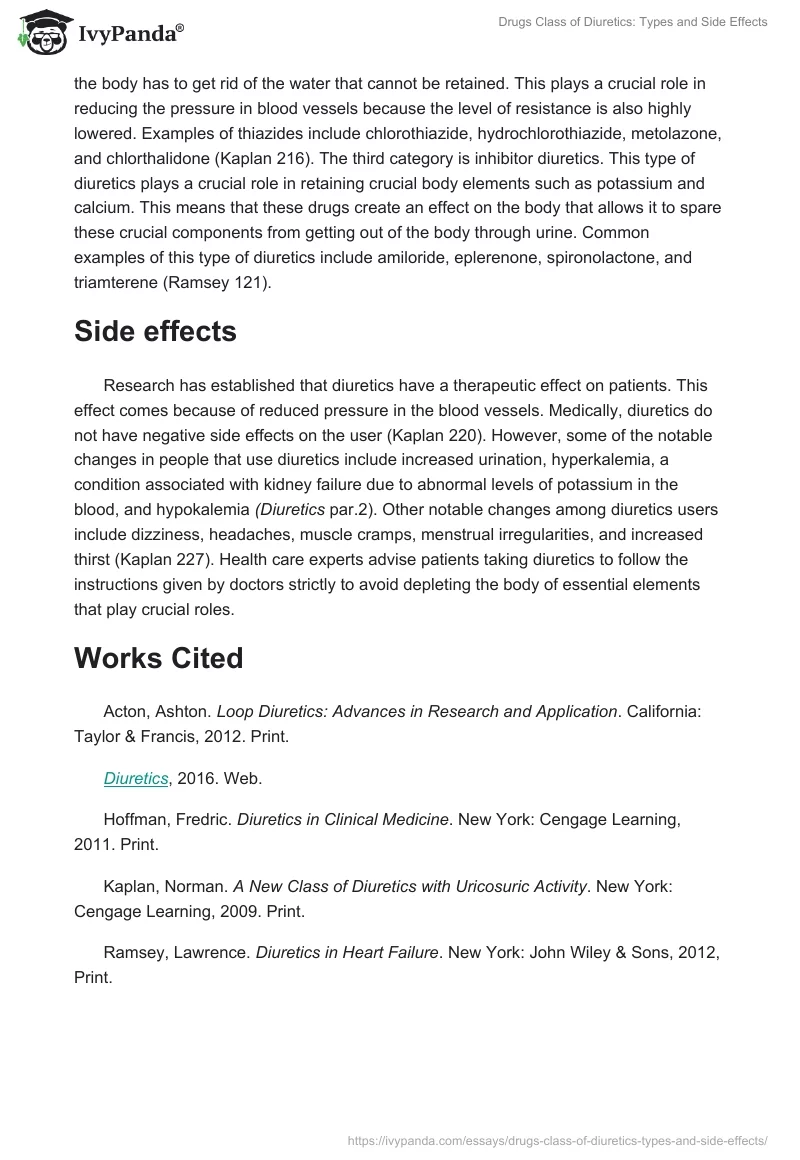Diuretics are a drug class that is used in treating chronic body conditions such as high blood pressure, kidney diseases, and water poisoning (Diuretics par.1). Studies have established that diuretics also apply in treating other conditions that include osteoporosis, diabetes insipidus, polycystic ovary syndrome, and edema among others (Hoffman 30). They are commonly referred to as water pills because they contain a substance that makes the body get rid of excess water, thus increasing the flow of urine. Diuretics use the kidneys to increase the amount of salt in the urine. The high quantities of sodium help in reducing the amount of liquid in the blood vessels, thus easing the pressure felt in the blood vessels (Ramsey 100). Research has established that diuretics are often abused by people with weight issues and eating disorders, as they often consider them as an easy solution. One of the most affected categories is those suffering from bulimia, an eating disorder common among women characterized by pathological insatiable hunger (Hoffman 36). Athletes have also been known to abuse diuretics when they intend to pass various drug tests done using urine samples (Kaplan 201). This abuse has led to diuretics being banned across all sporting circles by anti-doping agents.
Types of diuretics
Diuretics are categorized into three major types. In the first category, there is a high ceiling loop diuretic. It causes increased secretion of urine (Diuretics par.2). This happens because of their ability to reabsorb the salt that goes up the sphere of the small tubules that act as excretory units of the kidney (Acton 66). Although this often happens because of increased water intake combined with the effect of diuretic drugs, experts warn that substantial dieresis should be handled with caution, as it could be a sign of an underlying problem such as diabetes mellitus. Some of the common examples of this type of diuretics include bumetanide, ethacrynic acid, furosemide, and torsemide (Ramsey 109). The second category of diuretics is thiazides. These drugs are commonly used in the treatment of hypertension because of their ability to block the reabsorption of sodium in the kidneys. This often leads to frequent urination because the body has to get rid of the water that cannot be retained. This plays a crucial role in reducing the pressure in blood vessels because the level of resistance is also highly lowered. Examples of thiazides include chlorothiazide, hydrochlorothiazide, metolazone, and chlorthalidone (Kaplan 216). The third category is inhibitor diuretics. This type of diuretics plays a crucial role in retaining crucial body elements such as potassium and calcium. This means that these drugs create an effect on the body that allows it to spare these crucial components from getting out of the body through urine. Common examples of this type of diuretics include amiloride, eplerenone, spironolactone, and triamterene (Ramsey 121).
Side effects
Research has established that diuretics have a therapeutic effect on patients. This effect comes because of reduced pressure in the blood vessels. Medically, diuretics do not have negative side effects on the user (Kaplan 220). However, some of the notable changes in people that use diuretics include increased urination, hyperkalemia, a condition associated with kidney failure due to abnormal levels of potassium in the blood, and hypokalemia (Diuretics par.2). Other notable changes among diuretics users include dizziness, headaches, muscle cramps, menstrual irregularities, and increased thirst (Kaplan 227). Health care experts advise patients taking diuretics to follow the instructions given by doctors strictly to avoid depleting the body of essential elements that play crucial roles.
Works Cited
Acton, Ashton. Loop Diuretics: Advances in Research and Application. California: Taylor & Francis, 2012. Print.
Diuretics, 2016. Web.
Hoffman, Fredric. Diuretics in Clinical Medicine. New York: Cengage Learning, 2011. Print.
Kaplan, Norman. A New Class of Diuretics with Uricosuric Activity. New York: Cengage Learning, 2009. Print.
Ramsey, Lawrence. Diuretics in Heart Failure. New York: John Wiley & Sons, 2012, Print.


